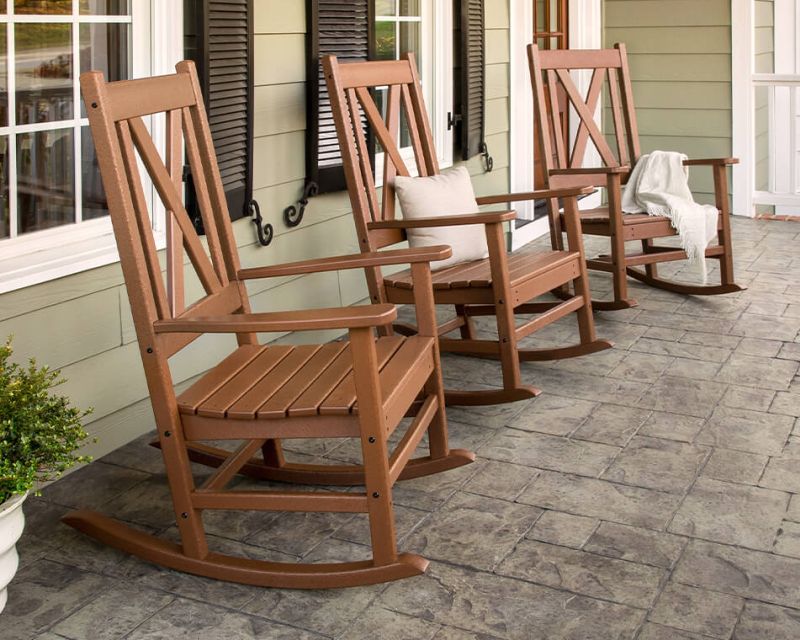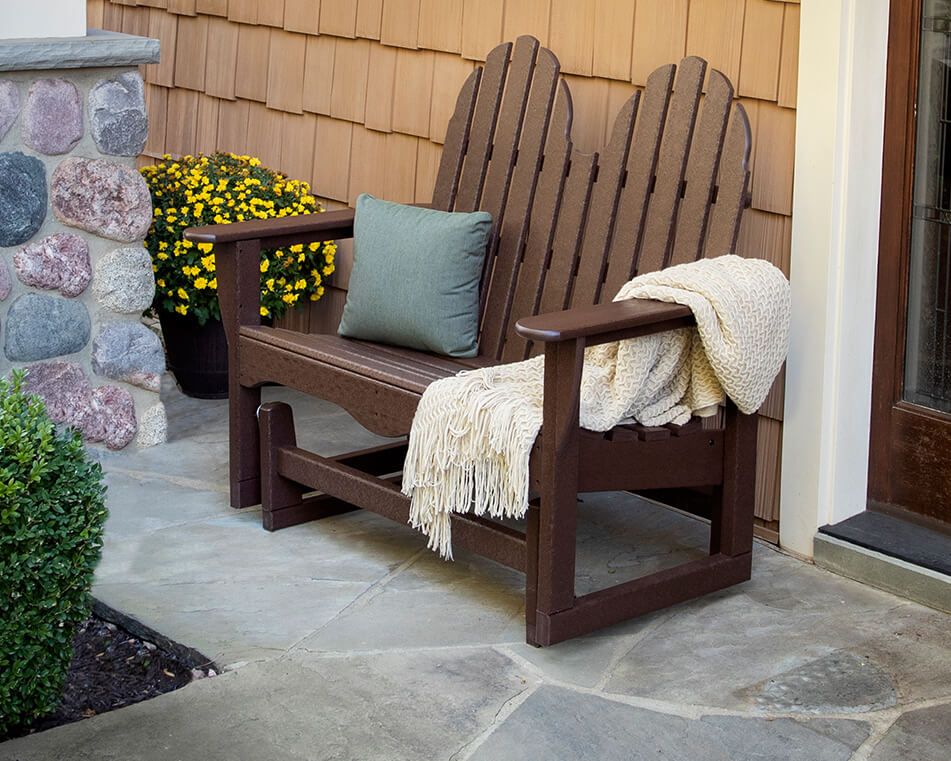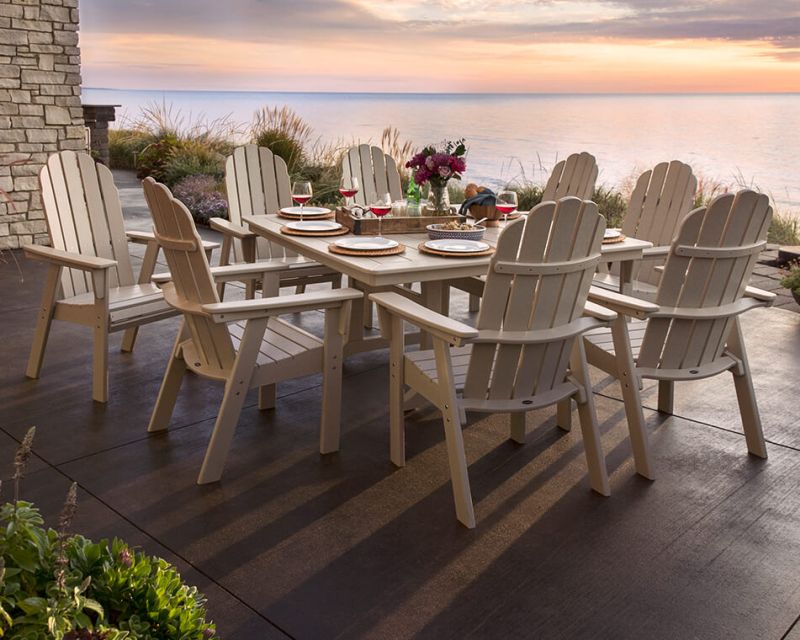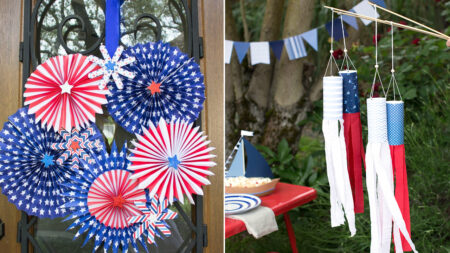Polywood furniture has been circling my internet feed for quite some time. Initially, I was somewhat skeptical, since I had never spent time searching for terms like ‘plywood’ or ‘polywood,’ nor had I scoured for related phrases such as ‘particle board’ or ‘polyester.’ However, I was looking for outdoor furniture made of recycled material. Turns out, polywood furniture is an entirely different concept. Contrary to its name, it has no connection to wood other than its visual resemblance in terms of shape, style, and texture.
Polywood is a US-based furniture company that makes outdoor furniture crafted from recycled plastic. It is important to clarify that polywood is not a material in itself, rather, its lumber is created from recycled and reusable high-density polyethylene (HDPE) plastic, sourced from items like plastic bottles, shampoo containers, and milk jugs.
Doug Rassi (CEO of Polywood) was one of the early visionaries to feed on the HDPE plastic recycling idea. He and his company started making outdoor furniture made of HDPE plastic and patented his company with the name ‘Polywood’. Rassi started bringing discarded materials into Polywood’s foundry, where they were recycled to form polywood outdoor furniture, including chairs, tables, and chaise lounges.
Subsequently, many other companies worldwide began producing similar items, albeit under different names due to Rassi’s patent. However, over time, ‘polywood’ became synonymous with HDPE and simultaneously became a widely recognized and googled term for this eco-friendly furniture.
What is Polywood Furniture and What is it Made of?
To simplify, polywood is premium furniture crafted from recycled material (HDPE plastic) with a manufacturing history spanning over 30 years. Renowned for its durability, this furniture boasts an average life span of 15 years and can withstand environmental factors like mold and fading while maintaining a beautiful appearance over time.

Polywood furniture doesn’t require any painting or staining for readiness as it comes pre-designed to emulate the look and feel of traditional wooden furniture. On top of that, it is coated with high-density foam, which makes it durable for outdoor use. Another USP of this versatile furniture is its toughness which makes it resistant to UV rays, salt water, mold, and mildew damage. So, if you are one of the folks tired of using wooden and metal furniture for your garden, polywood comes out as a fancy alternative that is durable, aesthetic, and functional.
How is Polywood Furniture Made?
Polywood outdoor furniture is made by mixing recycled plastic with color pigments and UV inhibitors. This mixture is then molded into the desired shape and treated with additional UV inhibitors to ensure long-lasting color and protection from the elements. It is also available in different shapes and prices to suit every budget and décor type.
Why Should You Choose Polywood Over Wood and Metal?
The way I see it, furniture is an investment. Whether buying a sofa for my living room or chairs for my patio, I am always mindful that the furniture I am investing in is long-lasting, well-designed, and versatile. Surely, that’s the case with you, too. For years though, we have relied on wood and metal furniture to adorn our homes and gardens, but they both have their shortcoming.
Wood is vulnerable to water and when moisture soaks into wood furniture, it leads to the splitting and swelling of furniture, and ultimately to rot. Metal furniture, on the other hand, is durable but heavy, thus being difficult to move and carry around. It is almost impossible for you to use metal chairs left in the sun and no matter how much you maintain them, outdoor metal furniture will get rusted over time.
Enter Polywood as an alternative. It’s designed to withstand outdoor elements, making it an ideal choice for all types of al-fresco settings. Polywood is engineered to resist fading, cracking, splintering, and warping under various weather conditions, including intense sun, rain, snow, and saltwater. Its unique composition makes it immune to the common issues that affect wood and other furniture materials exposed to outdoor environments.
The next question arises, can polywood furniture be left outdoors year-round? Yes, it is designed to be left outside in all the seasons. Its material withstands extreme weather conditions, making it suitable for any climate without the risk of damage.
Another query that many would have is whether polywood furniture fades or loses its color. No, it retains its color even when exposed to intense sunlight or harsh weather. The color is infused throughout the material, so it doesn’t fade or require repainting.
Pros of Polywood Furniture
It is durable: Polywood is made from high-density polyethylene (HDPE) plastic, which is known for its strength and resistance to weather, UV rays, and fading. The furniture made from polywood is therefore strong, sturdy, and built to last. It’s a great choice for families with kids and pets that can accidentally damage wooden furniture.
Easy to clean: You can quickly wipe off the polywood furniture with a damp cloth or sponge. The furniture cleans up easily with the use of soap and water (or any other mild detergent). Set it outside in direct sunlight if you have to air out the smell or stains from spills or accidents. Even food oils don’t stand a chance against this durable material.

Low maintenance: Polywood furniture is low in maintenance, especially in comparison with real wood furniture such as teak or pine, which requires more upkeep (i.e. sanding/painting every few years). Given its construction, the furniture does not require varnish or paint and its polyurethane coating protects against moisture. With added durability, the furniture can last longer than pieces made from untreated wood. Durable material properties ensure the polywood furniture retains its natural beauty over time instead of fading when exposed to the sun.
Eco-Friendly and Weather Resistant: Polywood is made from recycled plastic, making it an eco-friendly option for outdoor furniture. It can also withstand harsh weather conditions, making it ideal for outdoor use.
Available in various styles: Polywood furniture comes in a range of styles and colors, allowing you to choose the perfect piece to suit your outdoor décor.
Also Read: Most Famous Chair Designs of All Time
Cons of Polywood Furniture
But all is not merry with polywood furniture. Like all other furniture materials, this furniture can also have its demerits:
Limited life expectancy: Polywood is not a natural material, so it can’t be expected to last as long as most wood furniture. If you’re the type who likes to replace your couch every 10 years or so, then this may not matter much to you, though it’s worth noting that genuine teak and mahogany pieces tend to last longer. Even though polywood furniture is durable and long-lasting, it can over time start to show signs of wear and tear as well.
The polyurethane myth: While polyurethane has been proven safe in many years of use, some people may still be wary about using this type of material around their children or pets. There have been no studies showing that polyurethane emits harmful chemicals when exposed to UV light from the sun (or any other source), but that doesn’t stop parents from worrying about these things anyway. Some people also do not fancy the synthetic look of high-density polyethylene made furniture and prefer the natural appearance of other materials.

Heavier and uncomfortable: Polywood furniture is typically heavier than other types of outdoor furniture materials, making it more difficult to move around. Moreover, some homeowners complain that it is not as comfortable as other outdoor furniture materials, such as wood or wicker.
Is Polywood Furniture Eco-Friendly?
Yes, polywood furniture is eco-friendly. The entire guide about this furniture wouldn’t have made sense had it not been eco-friendly. The makers along with the likes of Polywood claim that this furniture is made from up to 90% recycled plastics, reducing the amount of waste in landfills and decreasing the demand for new plastic production.
Price of Polywood Furniture
Where there is a will, there is a way; and where there is polywood, there are pennies charged for it. On a little downside, this furniture tends to be pricier than other types of outdoor furniture, such as plastic, wicker, and aluminum. It’s more expensive than most of your indoor furniture as well.
However, polywood products can be customized to fit your specific needs and budget. For instance, you can choose from a variety of colors for your tabletops and chairs or order matching cushions so that everything looks like one cohesive set.
If you’re on a tight budget but need something durable that will last through many seasons of outdoor use, consider ordering just one piece of polywood furniture instead of the whole set at once. As time goes by and your budget allows, you can add more pieces to your collection until you have an entire polywood patio set.
How to Clean Polywood Furniture?
To buy any piece of furniture is one thing but to keep it clean and tidy is a whole different challenge. One of the best aspects of buying polywood furniture is that it is effortless to clean. Unlike traditional wooden and wicker furniture, a polywood chair or table requires minimal effort to clean. All you need is a soft cloth to wipe the furniture piece.
Be cautious of not using abrasive cleaners, polish or wax, hot water, or bleach on the furniture, as these chemicals have the potential to damage the polyurethane coating. Experts recommend using a mild solution of soap and water to clean any dirt or spills. For tougher stains, a soft-bristle brush can be used without damaging the furniture’s surface.
Design Value
Polywood furniture is an ideal choice for those looking to add some modern flair to their home. The intriguing design of the furniture is one of its most appealing features, as it has a sleek and refined look that’s sure to catch your eye.
The polywood material also makes this type of furniture ideal for those who want something that will stand the test of time. While there are plenty of options on the market today, many people prefer products that can last for years without needing replacement or repair work done on them and polywood fits the bill here!
FAQs About Polywood Outdoor Furniture
Q: How long does polywood furniture last?
A: If not broken intentionally, polywood furniture boasts an average life span of 15 years. However, it is not a natural material, so it can’t be expected to last as long as most wood furniture.
Q: Can polywood furniture be left outdoors year-round?
A: Polywood is coated with high-density foam, which makes it durable for outdoor use. On top of that, one need not cover this furniture as it is built to withstand all four seasons.
Q: Is polywood vulnerable to heat and water?
A: The biggest USP of polywood is its toughness. Polywood is resistant to UV rays, salt water, mold, and mildew damage. So, if you are one of the folks tired of using wooden and metal furniture for your garden, polywood comes out as a durable and functional alternative.
Q: Is polywood better than wood?
A: Wood is vulnerable to water and can lead to the splitting and swelling of furniture, and ultimately rot. Polywood, however, is tailor-made to resist fading, cracking, splintering, and warping under various weather conditions, including intense sun, rain, snow, and saltwater.
Final Thought
Overall, polywood furniture is a good option for those who expect longevity and durability in the chairs, tables, and chaise lounges they buy. The wood-like lumbers will not only withstand seasons of use but also add aesthetics to your backyard, garden, or patio.
Follow Homecrux on Google News!





Well said! This article is well-written and will help a lot of readers.